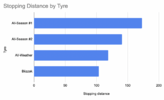Disclaimer: my conclusions are calculations based on my application of presumed simple newtonian mechanics. Since my ability to even pass an O level physics exam without some review is uncertain, I welcome critical review and corrections as appropriate.
Phew ! On to the story ...
I watched a very nice winter driving test done by TFL. In it they measured the time it takes to go from 0 to 25 mph, and stopping distances. Two AS tyres, an all-weather tyre, and the Blizzak were tested. To flesh out their results, I presumed that tyre friction to accelerate is the same as deceleration. This graph was the result

Then I wondered how much slower a car speed has to be to stop in the same distance as one with Blizzaks. I calculate it as (1 / sqrt of the acceleration time ratio). So e.g if comparing the AS #1 (9.8 sec) with the Blizzaks (6.85 sec), the AS tyred vehicle has to travel at 1 / sqrt(9.8/6.85) = 84% of the speed of the Blizzaked vehicle. A vehicle with All-weather has to travel at 96% the relative speed
YouTube Video Data. Stopping distance of the AS #1 (Michelin Primacy) is calculated
Add some more if you like ! I've had enough arithmetic for one day, but I think it would interesting to calculate reasonable winter driving speeds compared to posted speed limits (used in the summer) and following distances.
Phew ! On to the story ...
I watched a very nice winter driving test done by TFL. In it they measured the time it takes to go from 0 to 25 mph, and stopping distances. Two AS tyres, an all-weather tyre, and the Blizzak were tested. To flesh out their results, I presumed that tyre friction to accelerate is the same as deceleration. This graph was the result

Then I wondered how much slower a car speed has to be to stop in the same distance as one with Blizzaks. I calculate it as (1 / sqrt of the acceleration time ratio). So e.g if comparing the AS #1 (9.8 sec) with the Blizzaks (6.85 sec), the AS tyred vehicle has to travel at 1 / sqrt(9.8/6.85) = 84% of the speed of the Blizzaked vehicle. A vehicle with All-weather has to travel at 96% the relative speed
YouTube Video Data. Stopping distance of the AS #1 (Michelin Primacy) is calculated
Add some more if you like ! I've had enough arithmetic for one day, but I think it would interesting to calculate reasonable winter driving speeds compared to posted speed limits (used in the summer) and following distances.
Last edited:


